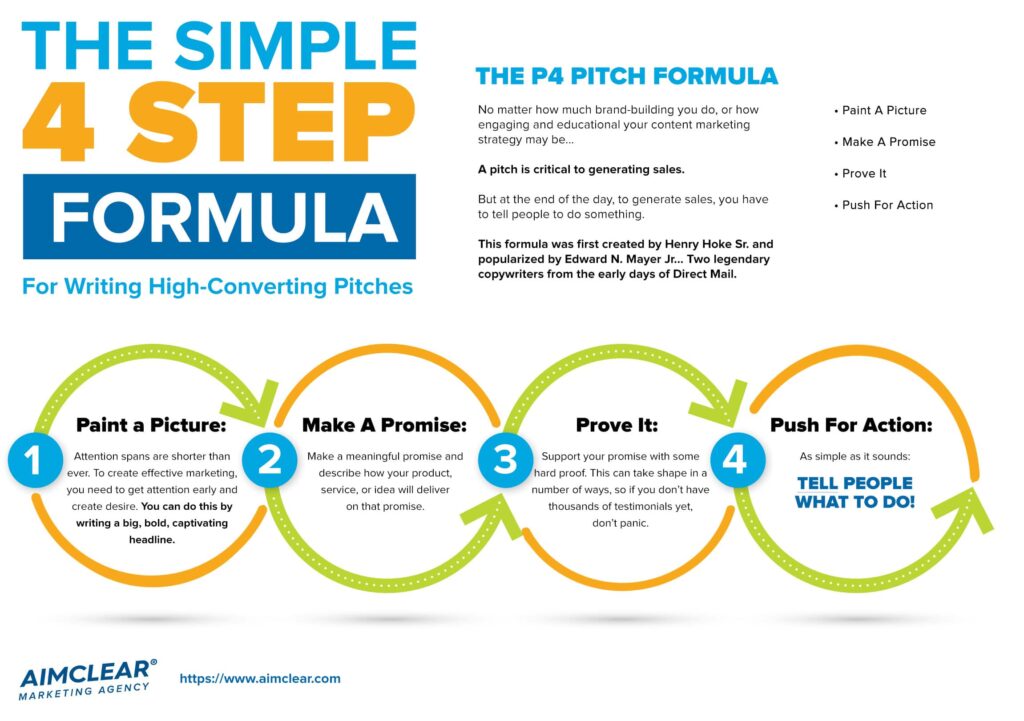Marketers love formulas, and Copywriters are no different.
Copywriters use formulas (and swipe files filled with snippets) for three main reasons:
- To kickstart the creative process
- To speed up the writing process
- And finally, because formulas are just cool 🙂
Perhaps the most powerful formula we’ve discovered and perfected over the years is a simple 4-step process for writing high-converting pitches.
No matter how much brand-building you do, or how engaging and educational your content marketing strategy may be…
A pitch is critical to generating sales.
And not to discredit the items mentioned above – 0f course brand building and engagement are important; of course you need to educate certain segments of your audience.
But at the end of the day, to generate sales you have to tell people to do something.
Tell them to click a link.
Get on an early bird list.
Buy your products!
This is where your pitch comes in, and the formula formula below simplifies and streamlines the writing process for you.
To my understanding, this formula was first created by Henry Hoke, Sr. and popularized by Edward N. Mayer Jr. – two legendary copywriters from the early days of direct mail. We’ve had significant success using it, and want to share it with you.
The “P4” Pitch Formula
- Paint A Picture
- Make A Promise
- Prove It
- Push For Action
Often, when I’m writing pitches, I’ll drop these bullets into a blank document, and start filling in each one:
Paint A Picture
Attention spans are shorter than ever. To create effective marketing, you need to get attention early and create desire. Write a big, bold, captivating headline.
Lots of experts have written great books on how to write headlines. I’ll probably write a blog post about it myself here someday.
For now, here are a few key tips:
- Keep it short.
- Find a fun, scary, interesting, or curiosity-driven angle you can take. Your primary goal with a headline is to keep people reading, so you really need to go big to catch attention, and stop the scroll.
- You know the tabloids you see at the grocery store when you’re checking out, like the National Enquirer? They often have great headlines.
- Be prepared to split-test your headlines! We’ve found headlines are the biggest lever we can press to improve conversions, so write several.
Make A Promise
Make a meaningful promise and describe how your product/service/idea will deliver on that promise.
Basically, you need to tie a unique mechanism to a core feature, and show how that leads to the desired outcome (benefit).
MECHANISM + FEATURE = BENEFIT
Some examples of how you could do this:
AIMCLEAR Sneakers have patented, adjustable “Snark Strap” technology [MECHANISM/FEATURE] that allows for a secure, personalized fit. [BENEFIT]
Proactive’s Combination Therapy [MECHANISM] attacks acne at every stage of the acne cycle [FEATURE] to keep skin looking clear and healthy. [BENEFIT]
A great way to start identifying these elements is by asking some bigger questions about your brand differentiators:
- Is your product faster or cheaper than your competitors?
- Is your product made better, or made with better materials? Is it more expensive for a reason?
- Is there a rich history? A recipe or company heritage that’s been passed down for generations?
- Do you offer a unique innovation that changes the game?
This “MECHANISM/FEATURE to BENEFIT” arc is really important because once the reader believes it, buying your product or service becomes the next logical and emotional decision.
Prove It
Support your promise with some hard proof. This can take shape in a number of ways, so if you don’t have thousands of glowing reviews or testimonials yet, don’t panic.
Here are some options:
- As mentioned above, testimonials and reviews (social proof) are worth their weight in gold. If you don’t have these yet, start collecting them!
- Trust/authority markers work great. This might include logos or mentions of high-profile clients you’ve worked with, or notable media outlets that have covered your product or service.
- Mention awards you’ve won, or certifications you’ve achieved.
Push For Action
As simple as it sounds: Tell people what to do!
Be direct. Try to avoid generalized call-to-action statements like “Click Here” and “Learn More” and instead, use stronger statements:
- Buy Now / Shop Now
- Call Us Now
- Sign Me Up
- Download The Guide
- Schedule Your Consultation
Depending on the space you have available you may also be able to tell potential buyers what happens after they order, which always goes that extra mile in making buyers feel safe moving forward.
Does It Work?
We’ve used variations of this formula to achieve some truly remarkable results over the years for some of the biggest brands on the planet, including Airbnb, Uber, eBay, Amazon, Dell, and many others.
This formula also works great from a cross-channel integration standpoint… Because once you identify the elements you’re going to use in each piece, you can use them over and over again for consistency of message.
Another bonus to using this formula: It can be applied to almost any piece of content, including something as short as a tweet, or as long as this very blog post you’re reading, right now.
Go back through it again and see if you can spot each of the sections and transitions 🙂
When you’re done, make sure to let us know your thoughts in the comments below.
Thanks for reading!










